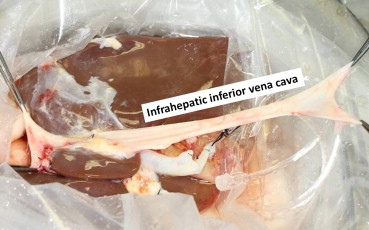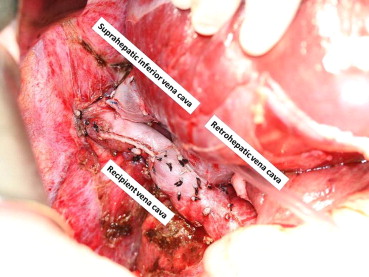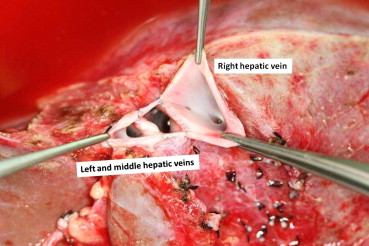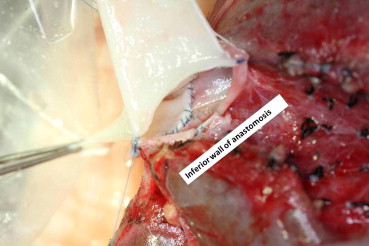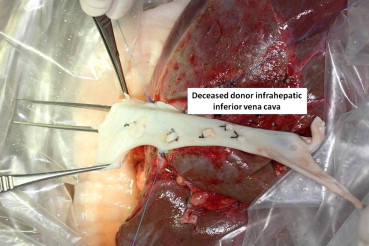Summary
Liver transplantation is a standard treatment for patients with familial amyloidotic polyneuropathy (FAP) with disease progression. Given the multiorgan involvement by amyloidosis, the heart is often involved. When poor cardiac function becomes prohibitive to liver transplantation, a combined heart-liver transplantation (CHLT) is the only realistic treatment. This article records a CHLT for a patient with FAP whose removed liver was immediately transplanted as an amyloidotic hepatic allograft (AHA) to a patient having hepatocellular carcinoma and cirrhosis in a sequential liver transplantation. In the CHLT, the heart and liver are donated by a deceased donor. The newly implanted heart did not tolerate cross clamping of the inferior vena cava (IVC), so a side-to-side anastomosis was performed to connect the IVC and that of the liver graft. Therefore, the AHA was devoid of an IVC. The infrarenal cava procured from the deceased donor was used for reconstruction of the AHA to match a whole graft used in routine deceased-donor liver transplantation. Venoplasty was performed using the graft right hepatic vein and the middle and left hepatic vein stump to form a single cuff. The reconstructed AHA was implanted to the recipient conveniently like a usual whole graft.
Keywords
amyloidosis;combined;heart;liver transplantation;sequential
1. Introduction
Multiorgan involvement is typical of familial amyloidotic polyneuropathy (FAP). Liver transplantation as the curative treatment for FAP has been well described.1 Early liver transplantation improves survival and often halts disease progression.2 If cardiac involvement is present, then the patient may require a combined heart-liver transplantation (CHLT), either simultaneously or sequentially. CHLT has been performed for hypercholesterolemia3 and FAP.4 In fact, FAP is the most common indication for CHLT, accounting for almost one-third of the cases.5 However, large case series of CHLT are lacking. Here, we discuss a case of CHLT for a patient with FAP. The operation required modification of liver transplantation techniques to cope with the newly implanted heart, which could not tolerate crossclamping of the inferior vena cava (IVC). The liver removed from the patient with FAP was then transplanted as an amyloidotic hepatic allograft (AHA) to a patient having hepatocellular carcinoma and cirrhosis in a sequential liver transplantation (SLT).
2. Case reports
2.1. Case 1
Case 1 is a 27-year-old woman with FAP. Her mother and maternal uncle both died in their early 40s from FAP. Genetic screening by restriction analysis and direct sequencing of the family members revealed the presence of the Val30Ala variant (a non-Val30Met variant) of mutation of the gene that produces transthyretin (TTR gene). The TTR gene mutation was first reported in Hong Kong in 1989 in a Chinese kindred 6 and years later in three other Chinese kindreds.7 The four kindreds were not related. TTR gene mutation is known to be associated with restrictive cardiomyopathy and progressive heart failure. 8 ; 9 Our patient had systemic neuropathy, including postural hypotension, and progressive weight loss from 72 to 55 kg over a 2-year period. Echocardiography and magnetic resonance imaging documented mildly dilated atria with thickening of the left ventricular wall with ejection fraction of 55%. Antral biopsy by upper endoscopy and endomyocardial biopsy both revealed amyloid deposits. After a full workup for heart transplantation and liver transplantation, an indication for both transplantations was ascertained. She was listed in both the heart and the liver transplant waiting lists.
A 19-year-old man who was braindead and with satisfactory cardiac and liver functions became available as a donor, and his heart and liver were allocated to our patient. Organ procurement was performed by flushing the aorta and inferior mesenteric vein with University of Wisconsin solution (NPBI, Emmer-Compascuum, the Netherlands). The cold ischemic time of the heart was kept at less than 4 hours. The infrahepatic IVC was included in the liver graft because the need for venous reconstruction was expected (Fig. 1).
|
|
|
Figure 1. Infrahepatic inferior vena cava was retrieved with the liver graft from the deceased multiorgan donor in anticipation of the need for venous reconstructions in the recipients. |
The heart transplantation was commenced with a sternotomy and standard cardiopulmonary bypass. The native heart was excised and the heart graft implanted. On reperfusion, the heart functioned satisfactorily. The histopathologic report of the removed heart indicated diffuse deposits of amorphous, eosinophilic materials showing salmon orange staining with Congo red and with apple-green birefringence under polarized microscopy, which is typical of amyloids. The amyloid deposits were found mainly in the subendocardial plane of the atria and ventricles, atrioventricular valves, and pericardial nerve bundles and vessels.
The liver transplantation commenced with a bilateral subcostal incision. The total hepatectomy of the native liver was started with hilar dissection to isolate the common bile duct, common hepatic artery, and main portal vein. Suprahepatic, infrahepatic, and retrohepatic IVC were then isolated. After crossclamping of the infrahepatic and suprahepatic IVC, the patient was hemodynamically unstable. The liver was separated from the retrohepatic IVC by ligating and dividing the short hepatic veins. Careful sharp dissection of the adventitia around the hepatic veins ensured sufficient length of the common trunk of the right, middle and left hepatic veins in the liver. After division of the portal vein, a TA30 vascular stapler [TA30, V3 (2.5 mm), United States Surgical Corporation, Norwalk, CT, USA] was applied to the right hepatic vein at a right angle flush with the IVC. The right hepatic vein was then divided with scissors. A Satinsky clamp was then applied to the middle and left hepatic vein stump, also at a right angle to the IVC, and the stump was divided with scissors. The liver was delivered. The stump was closed with 5/0 Prolene continuous suture, back and forth.
Sideclamping of the IVC was performed using a Satinsky clamp. Stapling of the suprahepatic and infrahepatic IVC of the deceased-donor whole liver (1310 g) was performed using the TA30vascular stapler. The liver was implanted by a side-to-side anastomosis of the graft IVC and the recipient IVC. The graft was flushed with 1 L of cold plasma. An effluent of University of Wisconsin solution (NPBI, Emmer-Compascuum, the Netherlands) was led out via the IVC before completion of the anastomosis. A bulldog vascular clamp was applied to the main portal vein of the graft. In order to restore hemodynamic stability, and the Satinsky clamp was released to return the venous circulation completely via the native IVC. Anastomosis of the graft main portal vein and the recipient main portal vein was then performed. After release of the portal vein, the graft swelled and the recipient developed hypotension. To improve the venous outflow of the graft, its suprahepatic IVC was anastomosed to that of the recipient, end-to-side (Fig. 2). The graft became soft and the recipient’s blood pressure became stable. Hepatic artery and duct-to-duct anastomoses followed.
|
|
|
Figure 2. Side-to-side anastomosis connecting the graft retrohepatic IVC and the recipient retrohepatic IVC. End-to-side anastomosis connecting the graft suprahepatic IVC and the recipient middle and left hepatic vein stump. IVC = inferior vena cava. |
The recipient made a satisfactory recovery from the CHLT and was discharged from the hospital 1 month later. Her heart and liver functions were satisfactory 15 months after the operation.
2.2. Case 2
The liver of the patient in Case 1 was then transplanted in a SLT to a 62-year-old man with a 2.4-cm hepatocellular carcinoma in segment 8 and Child-Pugh C cirrhosis. The possibility of SLT had been discussed with him during outpatient sessions and he agreed to accept an AHA. Total hepatectomy was performed for his native liver. The AHA (990 g), devoid of IVC, was trimmed on the back table. The infrahepatic IVC from the deceased donor was used for reconstruction of the AHA. The right hepatic vein (25 mm) and the common trunk of the middle hepatic vein (16 mm) and left hepatic vein (20 mm) were merged into a single triangular cuff (base, 20 mm; height, 30 mm; Fig. 3). A venotomy of the same size and shape was made on the deceased-donor infrahepatic IVC for insetting of the hepatic veins of the AHA (Figure 4 ; Figure 5). The AHA, now with IVC, was implanted to the recipient. Good venous outflow was checked by intraoperative ultrasonography. The recipient’s recovery was uneventful and he was discharged on postoperative Day 11. His postoperative condition remained satisfactory.
|
|
|
Figure 3. Venoplasty of the amyloidotic hepatic allograft right hepatic vein and middle and left hepatic vein common trunk into a triangular single venous cuff. |
|
|
|
Figure 4. Insetting of the amyloidotic hepatic allograft hepatic venous cuff to the deceased-donor infrahepatic inferior vena cava. |
|
|
|
Figure 5. Completed graft hepatic vein to inferior vena cava anastomosis. |
3. Discussion
CHLT and SLT exemplify the importance of planning for contingency. The patient discussed in Case 1 experienced hemodynamic instability on a trial of crossclamping of the IVC. Although cardiopulmonary bypass could be reinstituted, anticoagulation would be required. The problem was solved by sideclamping of the IVC and side-to-side IVC anastomosis. The venous outflow of the liver graft turned out to be inadequate. Although the size of the anastomosis should be large enough, hepatic venous blood had to take a hairpin turn instead of a direct pathway to reach the suprahepatic IVC before entering the native IVC. The graft retrohepatic IVC might also be compressed by the native IVC, which was fully expanded after restoration of circulation. The segment of the native IVC cephalic to the side-to-side anastomosis was narrowed due to the application of the TA30 vascular stapler when closing the right hepatic vein stump. To rectify the problem, additional anastomosis was made to connect the graft suprahepatic IVC and the common trunk of the left and middle hepatic veins of the recipient.
Although the heart was being implanted, the liver was cooled with ice-cold wet towels. The just-implanted heart was very susceptible to arrhythmia and depression of blood pressure after recirculation. However, in a more recent transplantation by another center, the heart reached stability a few hours after implantation and the subsequent implantation of liver was safe.9
Classically, the liver removed from a patient with FAP is transplanted to another patient in need of liver transplantation. The recipient of an AHA is usually older than 60 years of age. The AHA will continue to produce amyloid deposits, resulting in development of neuropathy in the recipient years later.
A deceased-donor liver graft contains the IVC, so the native liver of a patient with FAP who is receiving a deceased-donor liver is removed with the IVC included. Hence, liver implantations in the two recipients (the patient with FAP and the AHA recipient) are performed by end-to-end IVC anastomosis.
Total hepatectomy in a patient with FAP is similar to that seen in a standard deceased-donor liver transplantation, except that the liver is removed with the suprahepatic and infrahepatic IVC and just enough adequate length is included for subsequent implantation to an AHA recipient. Liver removal performed in a patient with FAP is a recipient of a total hepatectomy and a donor of a total hepatectomy at the same time, so it is important to note that a patient with FAP should not be disadvantaged for being a living donor. A way to maintain IVC flow during the anhepatic phase without veno–venous bypass is to apply the piggyback technique.10 This technique has also been applied to patients with FAP with end-to-side cavo–caval anastomosis and closure of the suprahepatic and infrahepatic vena cava. The stumps of the AHA were kept short to allow ample length of the suprahepatic and infrahepatic IVC in thepatient with FAP for easier liver implantation. This practice maintained the principle that liver donation by a patient with FAP should not increase the risk of liver transplantation the patient receives.11
For implantation of an AHA without the IVC, hepatic vein venoplasty can be performed to the IVC of the AHA recipient. The procedure is akin to but different from the piggyback technique because the lengths of the hepatic veins in the AHA are limited.12 AHA hepatic veins merged by venoplasty can be lengthened by incorporating a venous patch. This facilitates graft implantation by end-to-side anastomosis in a piggyback fashion.13 In the case reported herein, the deceased donor’s liver given to thepatient with FAP provided a long enough infrahepatic IVC, which was used to reconstruct the AHA to match a whole liver graft containing the IVC used in routine deceased-donor liver transplantation.
The planning of complex organ transplantations should be detailed and include contingency plans. In procurement of deceased-donor organs or tissues, variations of the implantation procedure should be anticipated. In the cases reported above, the venous outflow reconstructions improvised were facilitated by the availability of the infrahepatic IVC procured from the deceased donor.
References
- 1 A. Furtado, L. Tome, F.J. Oliveira, E. Furtado, J. Viana, R. Perdigoto; Sequential liver transplantation; Transplant Proc., 29 (1997), pp. 467–468
- 2 S. Yamamoto, H.E. Wilczek, G. Nowak, et al.; Liver transplantation for familial amyloidotic polyneuropathy (FAP): a single-center experience over 16 years; Am J Transplant, 7 (2007), pp. 2597–2604
- 3 T.E. Starzl, D.W. Bilheimer, H.T. Bahnson, et al.; Heart-liver transplantation in a patient with familial hypercholesterolaemia; Lancet, 1 (1984), pp. 1382–1383
- 4 M. Rela, P. Muiesan, N.D. Heaton, et al.; Orthotopic liver transplantation for hepatic-based metabolic disorders; Transpl Int, 8 (1995), pp. 41–44
- 5 H.S. Te, A.S. Anderson, J.M. Millis, V. Jeevanandam, D.M. Jensen; Current state of combined heart-liver transplantation in the United States; J Heart Lung Transplant, 27 (2008), pp. 753–759
- 6 C.M. Mak, C.W. Lam, S.T. Fan, C.L. Liu, S.C. Tam; Genetics of familial amyloidotic polyneuropathy in a Hong Kong Chinese kindred; Acta Neurol Scand, 107 (2003), pp. 419–422
- 7 C.M. Mak, Y.L. Kwong, C.W. Lam, et al.; Identification of a novel TTR Gly67Glu mutant and the first case series of familial transthyretin amyloidosis in Hong Kong Chinese; Amyloid, 14 (2007), pp. 293–297
- 8 S. Ikeda, Y. Takei, T. Tokuda, M. Nakazato, Y. Ando; Clinical and pathological findings of non-Val30Met TTR type familial amyloid polyneuropathy in Japan; Amyloid, 10 (Suppl. 1) (2003), pp. 39–47
- 9 A.P. Barreiros, F. Post, M. Hoppe-Lotichius, et al.; Liver transplantation and combined liver-heart transplantation in patients with familial amyloid polyneuropathy: a single-center experience; Liver Transpl, 16 (2010), pp. 314–323
- 10 K.S. Reddy, T.D. Johnston, L.A. Putnam, M. Isley, D. Ranjan; Piggyback technique and selective use of veno-venous bypass in adult orthotopic liver transplantation; Clin Transplant, 14 (2000), pp. 370–374
- 11 S. Nishida, A. Pinna, R. Verzaro, et al.; Domino liver transplantation with end-to-side infrahepatic vena cavocavostomy; J Am Coll Surg, 192 (2001), pp. 237–240
- 12 S.C. Chan, C.M. Lo, K.K. Ng, K.S. Chok, S.T. Fan; Simplifying hepatic venous outflow reconstruction in sequential living donor liver transplantation; Liver Transpl, 15 (2009), pp. 1514–1518
- 13 C. Liu, C.C. Loong, C.Y. Hsia, M.Y. Tsou, H.L. Tsai, C.F. Wei; Venoplasty of hepatic venous outflow with a venous patch in domino liver transplantation; Liver Transpl, 14 (2008), pp. 1378–1379
Document information
Published on 26/05/17
Submitted on 26/05/17
Licence: Other
Share this document
Keywords
claim authorship
Are you one of the authors of this document?
